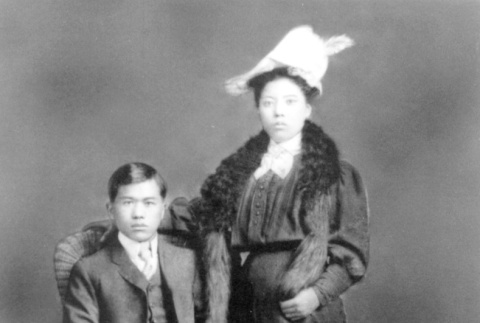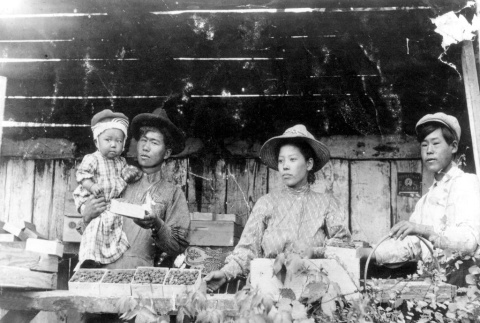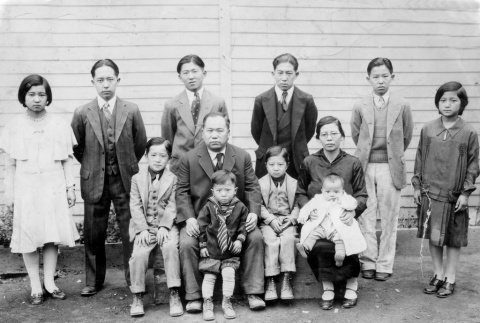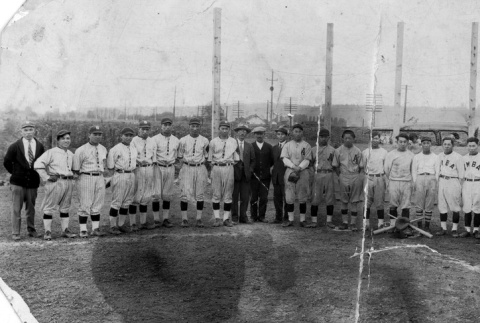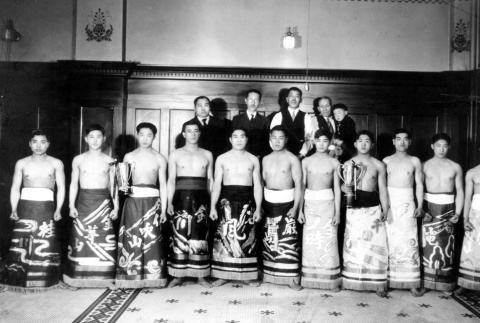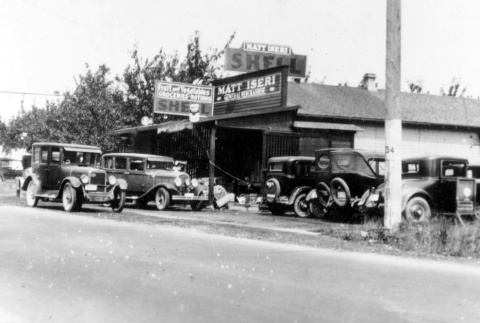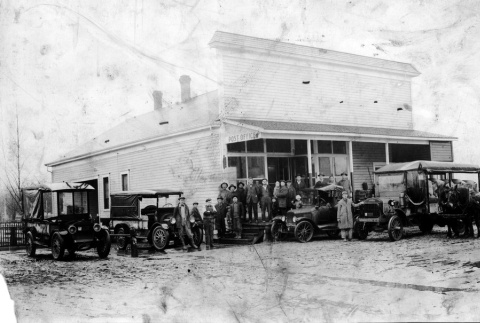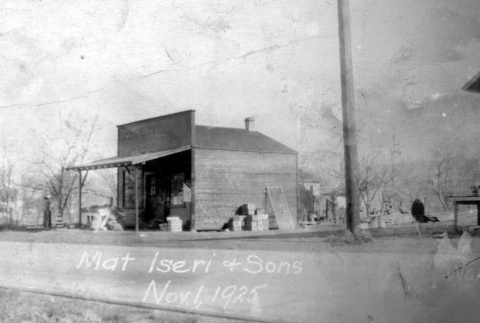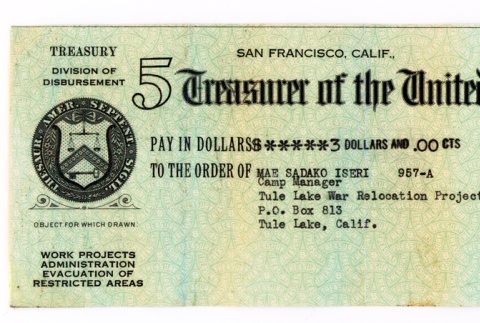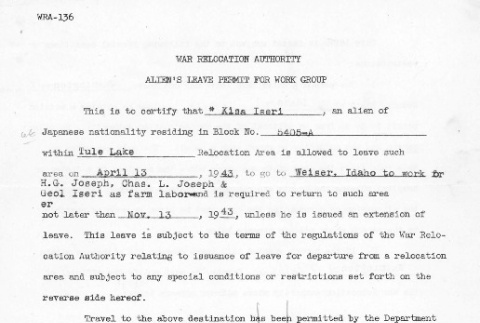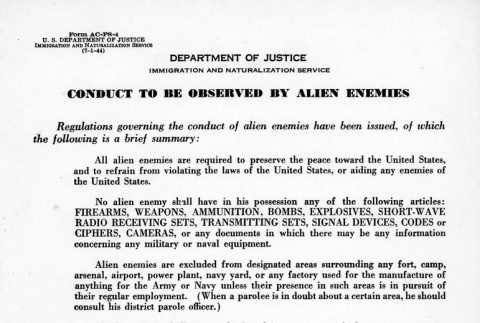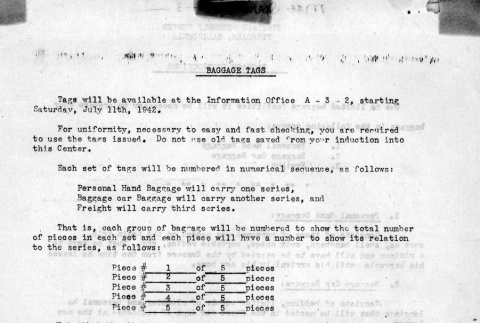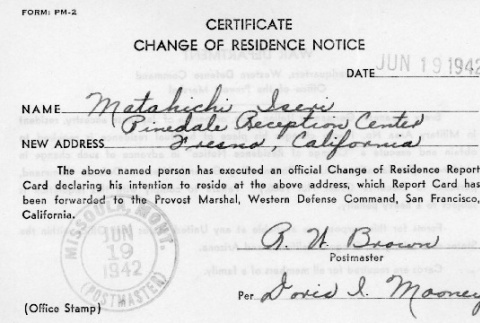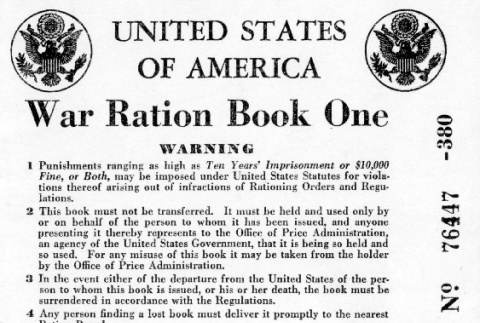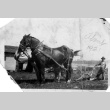Yamada Collection ddr-densho-25
99 items
99 items
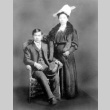
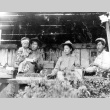
img
Packaging berries (ddr-densho-25-2)
Matahichi and Kisa Iseri leased a farm in Sumner and grew raspberries for various canneries. The wooden berry "cups" were handmade locally. Left to right: Matahichi Iseri carrying oldest son Tom, Kisa Iseri, and their nephew, Tsukasa Iseri.

img
Family portrait (ddr-densho-25-3)
The Iseris were a prominent Japanese American family in the White River Valley. Front (left to right): George, Matahichi, Oscar (in front of Matahichi), Dan, and Kisa holding Carl. Back: Alice, Tom, Mitsuo (Mike), Mun, Masato, and Mae. Matahichi Iseri and his wife, Kisa, started farming in Thomas around 1914. They also ran a small grocery …

img
Funeral procession (ddr-densho-25-4)
Horse-drawn funeral procession for Heiju Iseri of Thomas, Washington.
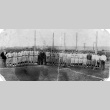
img
Baseball team (ddr-densho-25-5)
Baseball teams from different Buddhist churches competed against one another during the early 1930s. The teams were often created by the Young Buddhist Association (YBA). The team on the left is from Tacoma; the team on the right is from the White River Valley. Left to right (starting with the ninth man from the left): Reverend …
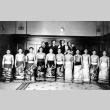
img
White River Valley sumo club (ddr-densho-25-6)
Sumo wrestling was a popular sport among the Issei and Nisei. This team from the White River Valley was in Tacoma for a tournament. Front row (left to right): Sam Katsura, Tom Marutani, Tom Hirai, Tony Tsujikawa, D. Kagitani, Frank Takeshita, George Hirai, Mitsuo (Mike) Iseri, unidentified, Ted Takeshita, and Ted Tsukamaki. Back row: Matahichi Iseri, …
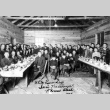
img
Opening celebration, White River judo dojo (ddr-densho-25-7)
Matahichi Iseri and his wife, Kisa, were very supportive of youth activities, and in 1927 they converted part of their warehouse into a judo dojo. This dinner was held to celebrate the opening of the dojo.
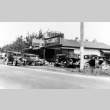
img
Issei-owned grocery store (ddr-densho-25-8)
Matahichi and Kisa Iseri immigrated from Kumamoto-ken, Japan, in the early 1900s. They became successful berry farmers in the White River Valley and also ran a small grocery store on their property. The World War II incarceration forced the Iseris to close both businesses. After the war, the Iseris settled in Ontario, Oregon, and worked as …

img
Issei-owned store (ddr-densho-25-9)
Matahichi and Kisa Iseri sold imported and dry goods from Japan as well as general merchandise to the Japanese American community in the White River Valley. When they started the business, the Iseris used their garage, as seen here. Later, they built a bigger store in front of their property.
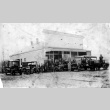
img
The Leonard Store (ddr-densho-25-10)
The Leonard Store was an important business in the White River Valley. Leonard introduced modern conveniences such as post office boxes and phones to the community. He also catered to the local Nikkei and imported various goods from Japan. Matahichi Iseri, a prominent Issei, worked for Leonard who promised to make him a partner in the …
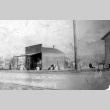
img
Issei-run store (ddr-densho-25-11)
Matahichi and Kisa Iseri ran a small store and berry farm in Thomas, Washington. Matahichi first opened the store in the family's garage shown here.

doc
Incarceree luggage tags (ddr-densho-25-14)
Japanese Americans were allowed to take only what they could carry to the camps. In most cases, a person could take two bags. Each bag was marked with an identification tag. These tags belonged to Mae Iseri who was initially detained at the Pinedale Assembly Center in California. Mae and her family were later incarcerated at …
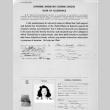
doc
JACL certificate of identification (oath of allegiance) (ddr-densho-25-15)
After the bombing of Pearl Harbor, Issei were required to carry government-issued identification documents because of their alien status. The Nisei, who were American citizens, did not have to carry such documents. However, the JACL encouraged Nisei to carry identification papers voluntarily. This document belonged to Mae Iseri. The document featured an oath of allegiance that …
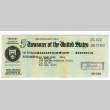
doc
Camp worker's paycheck (ddr-densho-25-16)
Mae Iseri was originally from Thomas, Washington, where her parents ran a small store and berry farm. After being held at the Pinedale Assembly Center in California, Mae was detained at the Tule Lake concentration camp, California, where she worked as a physical education teacher. This was her first paycheck, which she never cashed.
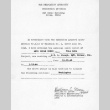
doc
Permit to extend seasonal work leave (ddr-densho-25-17)
From 1943 until 1945, the Iseri family lived in Weiser, Idaho, under the seasonal work leave program established by the WRA. Under this program, Japanese Americans could apply for permits to live and work on nearby farms. When Akio (Oscar) Iseri's permit expired, he applied for an extension.
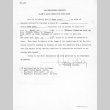
doc
Alien permit for seasonal work leave (ddr-densho-25-18)
In 1943, the Iseri family lived in Weiser, Idaho, under the seasonal work leave program. This program enabled Japanese Americans to apply for permits to live and work on nearby farms. Kisa Iseri, an Issei, had to apply for a special permit in order to join the rest of her family in Idaho. A list of …
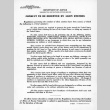
doc
List of regulations specifying conduct to be observed by "alien enemies" (ddr-densho-25-20)
Matahichi Iseri, considered a "dangerous enemy alien," was arrested on Dec. 7, 1941, and imprisoned in the Department of Justice internment camp at Fort Missoula, Montana. During the war, enemy aliens were not allowed to own contraband articles such as weapons, signal devices, and cameras. They were required to carry certificates of identification at all times, …

doc
Personal identification tags (ddr-densho-25-22)
During mass removal to assembly centers, each person of Japanese ancestry was required to wear a tag specifying his or her family's number for identification purposes. The Iseri family's number was 16799.

doc
Instructions for moving to camp (ddr-densho-25-23)
The Iseri family resided in the Pinedale Assembly Center from June until July, 1942. They then received instructions on how to prepare for their move to the Tule Lake concentration camp. The procedure was similar to that of leaving for the Assembly Centers: Japanese Americans packed their luggage, marked it with identification tags, and boarded the …
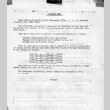
doc
Baggage identification tag instructions (ddr-densho-25-24)
The Iseri family was moved from the Pinedale Assembly Center to the Tule Lake concentration camp in July of 1942. They thus received instructions on how to label their baggage to ensure that none of it was lost.
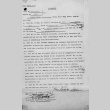
doc
JACL affidavit (ddr-densho-25-25)
Mae Iseri signed this affidavit when she became a member of the JACL. By signing, she swore allegiance to the United States, renounced allegiance to any other country, and condemned the "infamous machinations" of the Japanese government.
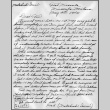
doc
Letter written by an Issei man to his family (ddr-densho-25-26)
While he was at Fort Missoula, Montana, a Department of Justice internment camp for enemy aliens, Matahichi Iseri wrote to his wife and children, who were still awaiting a relocation assignment from the WRA.
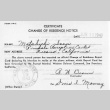
doc
Change of Residence Notice (ddr-densho-25-27)
Considered a "dangerous enemy alien," Matahichi Iseri was separated from his family and sent to the Department of Justice internment camp at Fort Missoula, Montana. In June 1942, he received a Change of Residence Notice certificate, which indicated that his request to join his family at the Pinedale Assembly Center in California had been approved.

doc
War Ration book (ddr-densho-25-29)
Within the War Relocation Authority Camps, the Office of Price Administration set up a system of War Ration Books. Camp inmates could purchase the books, which contained war ration stamps. The stamps enabled them to purchase items in the army stores in the camps. The purpose of the ration books was to help the war effort …
